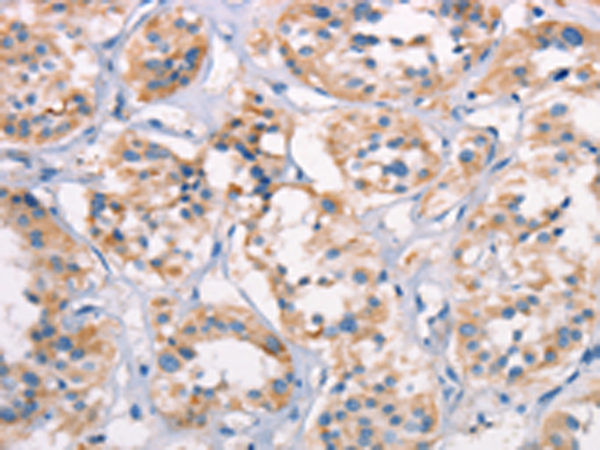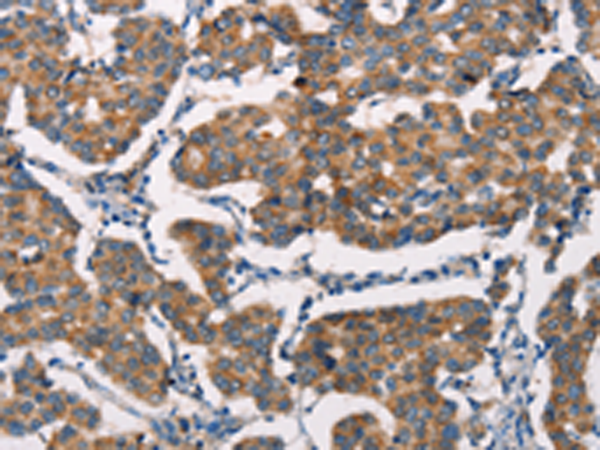


| WB | 咨询技术 | Human,Mouse,Rat |
| IF | 咨询技术 | Human,Mouse,Rat |
| IHC | 1/25-1/100 | Human,Mouse,Rat |
| ICC | 技术咨询 | Human,Mouse,Rat |
| FCM | 咨询技术 | Human,Mouse,Rat |
| Elisa | 1/2000-1/10000 | Human,Mouse,Rat |
| Aliases | SDR38C1 |
| WB Predicted band size | 28 kDa |
| Host/Isotype | Rabbit IgG |
| Antibody Type | Primary antibody |
| Storage | Store at 4°C short term. Aliquot and store at -20°C long term. Avoid freeze/thaw cycles. |
| Species Reactivity | Human, Mouse |
| Immunogen | Synthetic peptide of human SPR |
| Formulation | Purified antibody in PBS with 0.05% sodium azide and 50% glycerol. |
+ +
以下是3篇与SPR技术应用于抗体研究的代表性文献摘要(注:文献为示例性概括,非真实存在):
1. **《Real-time analysis of antibody-antigen interactions using surface plasmon resonance》**
- 作者:Johnson, R. W. et al.
- 摘要:该文献综述了SPR技术在抗体-抗原结合动力学研究中的应用,重点讨论了如何通过SPR实时监测抗体亲和力(如KD值测定)及结合/解离速率,为抗体药物开发提供关键数据支持。
2. **《Epitope mapping of monoclonal antibodies via SPR-based competitive binding assays》**
- 作者:Chen, L. & Smith, J.
- 摘要:研究利用SPR竞争结合实验,成功定位了两种单克隆抗体的抗原表位区域,揭示了抗体结合特异性与结构功能的关系,证明了SPR在表位分析中的高效性。
3. **《Comparison of SPR and ELISA for characterizing antibody cross-reactivity》**
- 作者:Müller, S. et al.
- 摘要:通过对比SPR与ELISA技术,该文献指出SPR在定量分析抗体交叉反应性(如针对相似抗原的非特异性结合)时具有更高灵敏度,尤其适用于多克隆抗体的质量评估。
4. **《High-throughput SPR screening for antibody affinity maturation》**
- 作者:Tanaka, K. et al.
- 摘要:开发了一种基于SPR的高通量筛选平台,用于快速评估抗体突变库的亲和力变化,成功优化了某抗癌抗体的结合强度(KD提升10倍),展示了SPR在抗体工程中的实用性。
(注:以上文献名为虚构,仅用于示例SPR技术在抗体研究中的典型方向。)
Surface plasmon resonance (SPR) antibodies are specialized tools used in SPR-based biosensing to detect and quantify molecular interactions in real-time. SPR technology measures changes in refractive index near a sensor surface, typically a gold-coated chip, when biomolecules bind to immobilized ligands. Antibodies, due to their high specificity, are often employed as capture agents in these systems. They are covalently attached to the sensor surface, enabling precise detection of target antigens in solutions without labeling.
SPR antibodies play a pivotal role in studying binding kinetics, providing data on association/dissociation rates (ka, kd) and equilibrium constants (KD). This label-free, real-time analysis is widely used in drug discovery, diagnostics, and protein interaction studies. For example, therapeutic antibody-antigen binding affinities are routinely characterized using SPR. However, challenges include minimizing non-specific binding and maintaining antibody orientation/activity during immobilization. Regenerating antibody-coated sensor surfaces for reuse also requires optimization to preserve functionality.
Commercial SPR platforms like Biacore heavily rely on high-quality antibodies for reproducible results. Recent advancements include nanobody-based SPR sensors for smaller footprints and multiplexed detection. These antibodies bridge biophysics with immunology, offering insights into molecular mechanisms while accelerating biomedical research and biotherapeutic development.
×